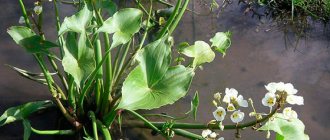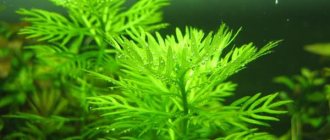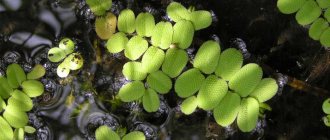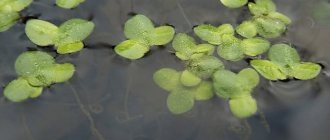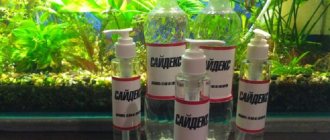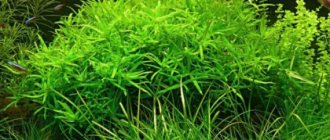There are many plants that are listed in the Red Book of Russia, but the water chestnut is definitely one of the most unusual. It is famous not only for its strange appearance - its fruits have processes similar to horns, for which it is called horned nut or devil's nut - but also for its rarity in nature and unique beneficial properties. It was they who served as one of the reasons for its gradual disappearance from water bodies.
Euryale is awesome
The Water Lily family, distributed in the Ussuri Region, India, Japan, and China. It is an annual, stemless aquatic plant. The leaves are long-petiolate and arrow-shaped in young plants. At a later time - round-oval, leathery, reaching 130 cm in diameter. The underside of the leaves of aquatic plants is slightly pubescent, violet-purple in color; the upper one is green, bare. It has strongly protruding veins on which numerous spines are located.
The plant is remarkable in that its leaves have numerous protuberances. Air bubbles accumulate under them, thanks to which the floating Euryale plants are held on the surface of the water surface of the reservoir.
The flowers are large, blue-violet in color with a reddish core, located on thin peduncles. Flowers and peduncles are covered with spines, bent down. The plant blooms in the second half of summer. The fruits are round, dark purple in color, weighing up to 200 g, covered with powerful thorns. The seeds are black, spherical, covered with sticky mucus, and ripen in September-October.
Euryale frightening is propagated by seeds. Each year the plant produces abundant, flat, spiny foliage. This original, light-loving plant is sown in reservoirs in the southern regions of the above countries.
Disease and pest control
| Cause | Fighting methods |
| Aphids and sawflies | Cut off damaged leaves and rinse the rest with running water. |
| Caddis flies | Remove caddisfly “houses” manually, acidify the environment |
| Moth caterpillars | Constant control over the flora; when it appears, treat it with a decoction of coriander or katran |
| Pond snails | Constant control over the flora, when snails appear, collect them manually, and also place a cabbage leaf in the water, which the snails will immediately begin to eat, which you will later throw out |
Mineral deficiency
| Add fertilizer |
| Black and diseased roots | Cut off damaged parts, add gravel or crushed stone to the soil |
| Small leaves | It is necessary to select temperature and light indicators |
| Stopping growth | Add carbon dioxide, adjust the pH of the aquatic environment |
| White coating on leaves | Add carbon dioxide |
| Leaves are small or red | Add Nutrients |
| The top of the plant is elongated | Move away from the immediate light source |
Beneficial features
In Russia, chilim has not proven itself as a medicine, but in Asian countries it is used to treat almost all diseases. And this is not surprising, since it has a lot of useful properties . It helps in the following situations:
- accelerates wound healing;
- has fixing properties, therefore it stops diarrhea - for this purpose you can eat its juice or fresh fruits;
- improves the functioning of the gallbladder and liver due to its choleretic properties;
- helps in the treatment of tumors, including malignant ones;
- treats the genitourinary system and kidneys, as it has a diuretic effect;
- its antiviral and antimicrobial qualities help cope with both purulent sore throat and colds, as well as herpes or gonorrhea;
- antispasmodic properties relieve pain of various natures.
It also affects the human nervous system. Examples of use:
- during stress and difficult life situations, it increases tone, helps to calm down and concentrate;
- in addition, it has general strengthening properties that support the body and restore after prolonged illnesses.
Medicines are made from all parts of the rogulnik: both from the inside of the fruit and from the leaves, flowers and stems. Both its freshly squeezed juice and alcoholic tinctures based on it, as well as decoctions and tinctures in a steam bath, have medicinal properties.
Medicines made from it help with the following diseases:
- impotence;
- toothache;
- atherosclerosis;
- snake and insect bites;
- eye diseases.
Using chilim juice you can treat herpes or insect bites. To do this, you need to apply the substance to the affected area and keep it for some time. In addition, you can rinse your mouth and throat with its solution (1:10) in case of inflammation.
A tincture of nuts and vodka is used to cleanse blood vessels. You should take ten nuts, pour a glass of vodka over them and leave for ten days. After this, you can take it three times a day, one tablespoon, for ten days in a row. You can repeat the course of treatment after a ten-day break.
An infusion of this plant can also be used for cosmetic purposes, lubricating acne and inflammation on the skin.
Although no allergy to chilim has been recorded, if you are individually intolerant, it is better to stop using it.
Water lily small or tetrahedral
The Water Lily family is distributed in the forest zone of North-Eastern Europe, Siberia, the Far East and North America. The differences that aquatic plants have in the Small Water Lily - the floating leaves and flowers (the diameter of which is 4-6 cm) are much smaller than those of the Nymphaeum Water Lily, the rhizome is much thinner.
However, the food value of this plant for small animals is great, since it grows precisely in the northern regions where the Nymphaeum water lily cannot grow.
Varieties of water lilies are also known: Water lily pure white (pure white flowers, diameter 6-10 cm); Pink water lily (pink flowers, 10-15 cm in diameter).
Reproduction method
Photo: what a water chestnut looks like.
Reproduction of floating water chestnuts occurs by seeds or vegetatively.
Seeds are carried by water currents or animals. Capable of remaining dormant in mud for up to 12 years. Trapa also reproduce vegetatively: parts of the parent plant are separated and carried downstream by water currents, where they survive long enough to produce seeds. Observations show that a 10-fold increase in the biomass of the floating water chestnut population can be achieved in one season. Each of the new plants will produce up to 20 seeds.
Cooking recipes
Chilim fruits are eaten both raw and boiled or baked. Moreover, this chilim resembles the taste of roasted chestnut fruits. Rogulnik is mainly used in Asian cuisine. But if you are lucky enough to purchase these wonderful fruits, then it is recommended to try them not only in their raw form:
- Chilim puree. To prepare you will need 200 grams of bagel, milk, butter, sugar. Cut the peeled fruits into cubes and place in a saucepan. Then you need to pour 150 grams of milk and cook under the lid for half an hour. As soon as the fruits are cooked, you need to grind them through a sieve or mash them with a masher, pour in the milk left over from cooking the nuts, add butter and sugar to taste. This puree is perfect for meat dishes.
- Stewed water chestnut. To prepare you will need 100 g of chilim, 100 g of apples, butter, sugar. Pour the cleaned chili with water and simmer under the lid. Peel the apples and cut into slices. Place peeled and chopped apples, butter and sugar to taste into the pan with the nuts. Cover with a lid and simmer until the fruit softens.
- Rogulnik is added to all kinds of salads: cucumbers, cabbage, radishes, and the taste of rogulnik can be enhanced with herbs, onions and garlic. Also, baked or scalded nuts can be used in the treatment of diarrhea: several fruits should be consumed every hour, and the cut out middle is an excellent remedy for toothache and gumboil.
- You can prepare an infusion of dried flowers and leaves for compresses and rinses: pour one tablespoon with one glass of boiling water and leave in a water bath for 15 minutes, then leave for about an hour. Then strain and use internally or externally. To preserve the nutritional and taste properties of the nut, it should be peeled immediately at the time of preparation.
It should be stored in a cool, dark place, for example, in the refrigerator, first wrapped in cotton cloth. Now, when you see a rosette of chilim leaves on the surface of a reservoir, you will know that it is not a weed growing in front of you, but a unique plant, incredibly tasty and rich in nutritional properties.
Where and how does it grow, is it grown in Russia?
Chilim can be found in the following areas:
- Africa;
- Central, eastern and southern parts of the European continent;
- Japan;
- China;
- Pakistan;
- India;
- Vietnam;
- Türkiye;
- Azerbaijan;
- Russian Federation (Siberia, Far East).
Where does water chestnut grow?:
- swamps;
- lakes;
- floodplains of fresh rivers with muddy bottoms and small currents.
The ideal environment for the growth and development of Chilima is clean water, otherwise the plant dies. In addition, the water chestnut hardly tolerates changes in light and temperature.
How to grow floating hornet correctly
Is it possible to plant dried bagel seeds?
Chilim seeds that have dried out and turned black are not viable and therefore will not be able to grow a new plant.
Plant care and maintenance
Photo: Water chestnut (Chilim)
Water chestnuts are grown primarily in China and imported to the United States and other countries. To achieve maturity, controlled watering and 220 frost-free days are required. The grass is planted 10-13 centimeters deep in the soil, 75 centimeters apart in rows, and then the field is watered and left for one day. After this, the field is drained and the damn nut grows 30 centimeters in height. Then, the field is watered again and left for the summer season. The variety ripens late in autumn, when the field is drained 30 days before harvest. Water chestnuts do not grow in swamps or ponds unless ditches are installed to control the water level.
Growth conditions:
- temperature from 30 to 35°C;
- minimum soil/water temperature 15°C;
- prefers slightly acidic soil conditions and a sunny position;
- fertile soil;
- grows best in rich clay soils;
- pH in the range of 6.9-7.3.
Pondweed grass-like (variegated)
The Rhododaceae family, distributed in the temperate zone of Eurasia and North America. This is a perennial rhizomatous plant with thin, highly branched stems. There are two types of leaves: underwater and floating. Underwater – numerous, lanceolate, translucent, forming the main vegetative mass. Pondweed is aquatic plants with floating leaves, the shape and structure of which resemble the leaves of floating pondweed.
The flowers are small, inconspicuous, collected in inflorescences - a thick spike. The fruits are spicate, with a short beak. Pondweed, like floating pondweed, overwinters at the bottom of reservoirs. In summer it is the favorite food of all aquatic animals and waterfowl. In winter - for animals in non-frozen areas of reservoirs.
Pondweed is a very variable species of Pondweed. So, when the water level in reservoirs rises, which leads to the deepening of the plant, its floating leaves die. When the reservoir dries out, the plant can take on a terrestrial form with leathery leaves narrowed into petioles.
Legends and legends about Eggs and Water Lilies
Legend 1 (about the white water lily). The scientific name of the water lily family (Nymph) is apparently given in honor of the beautiful white-faced young Nymph with a shock of golden hair, living in a forest lake. At night, sinking to the bottom of the lake, she slept peacefully. And in the morning, having risen to the surface of the water, I washed myself with dew from the coastal plants. Her life flowed calmly, surrounded by dryads and naiads in picturesque nature.
But one day, on the shore of the lake, she saw the then young Hercules. Sleep and peace left her, she stopped sinking to the bottom of the lake, meeting her friends - she was still waiting for Hercules to return. But he didn't come anymore. Life was slowly leaving the beautiful Nymph and this legend about the white Water Lily says that she soon turned into a snow-white flower with golden stamens. Every morning the flower opened on the surface of the lake, as if expecting and hoping to see Hercules again.
Legend 2 (about Mermaids and Water Lilies). Apparently, myths about Mermaids appeared among the Slavs because of the ability of water lilies to submerge in water. These pale-faced, slender beauties loved to comb their long, flowing, moon-colored hair on moonlit nights, sitting on stones and stumps on the shore of a forest lake. And when they saw random belated travelers, they caught them and pulled them into their watery kingdom.
Legend 3 (Water lilies - amulets). In ancient times in Rus', the water lily (white water lily) was called Odolen-grass. It was believed that she was capable of protecting people traveling to distant lands. Therefore, a piece of its rhizome was placed in an amulet and worn as an amulet. They also believed that its root should be carried by a shepherd so that his flock would not scatter. There was also a belief: “whoever dislikes you and wants to dry him, give him the root to eat.”
Legend 4 (love story of the Water King and Princess Nymph). Admiring the Egg Capsules and Water Lilies, people created legends about the origin of these amazingly beautiful plants. So, one Italian legend about the Water Lily says......
Among the picturesque hills covered with flowers, in the foothills of the Alps lies a blue, blue lake. During the day, under the rays of the sun, many different species of fish splashed in its water. And when the stars lit up in the sky and the Moon appeared, the lunar path ran across the water surface of the lake; The Water King lived in this lake.
Not far from the lake, on one of the hills, stood a magnificent ancient castle. The beautiful towers, turrets, and spiers of this castle were reflected in the water of this lake. Many generations passed in this castle during the life of the water king. But one day he saw a young, beautiful girl with golden, lush hair, eyes bluer than the waters of a lake, skin whiter than snowy mountains.
It was Nymph - the daughter of the owner of the castle. Seeing her, the Water King felt loneliness for the first time. But how to get closer to it? After all, only a light small cloud of gray fog could cling to the windows of the castle - this was his real appearance. And he could only inhabit a snag or a dead person. One day he heard that a ball was being prepared in the castle, at which Nymph was supposed to choose a groom.
That day, clinging to the windows of the castle, he watched with longing as the elegant guests who arrived were having fun, dancing - music was playing in the castle. And when dusk came, he saw a strange horseman appear on the road to the castle. He was sitting on a horse, for some reason backwards to front, muttering something indistinctly. True, he was young and handsome, dressed quite elegantly, and his horse was a thoroughbred. When the rider, driving a spur into the horse, made him fly up, the horse threw him to the ground. The young man groaned, but soon fell silent.
The water king felt sorry for this man, he bent over him. And a few moments later a young, handsome Stranger entered the castle hall. The music instantly stopped and there was silence in the hall. And suddenly his ironic, authoritative voice rang out: “why isn’t the music playing?” And the musicians, without even asking permission from the owner of the castle, began to play.
The guests made way for the stranger as he went to invite the Nymph to dance. They danced alone all evening; no one dared to enter the circle. “I’ll show you the whole world,” the Stranger whispered to the charming Nymph. Further, this legend about the Water Lily says that in the morning both disappeared, and no one ever saw them again. And on the blue, blue lake, Egg Caps and Water Lilies began to appear from time to time. Local residents said that it was the Water King and the Nymphs who visited this lake again.
What kind of plant is this?
The floating water chestnut (lat. Trapa natans) belongs to the genus of aquatic flowering plants of the Derbennikaceae family.
The annual plant is a medicinal product and is actively used in various branches of medicine.
Despite the fact that in 2008 this plant was excluded from the Red Book of the Russian Federation, it is protected at the local level in many regions of Russia, as well as in a number of countries:


